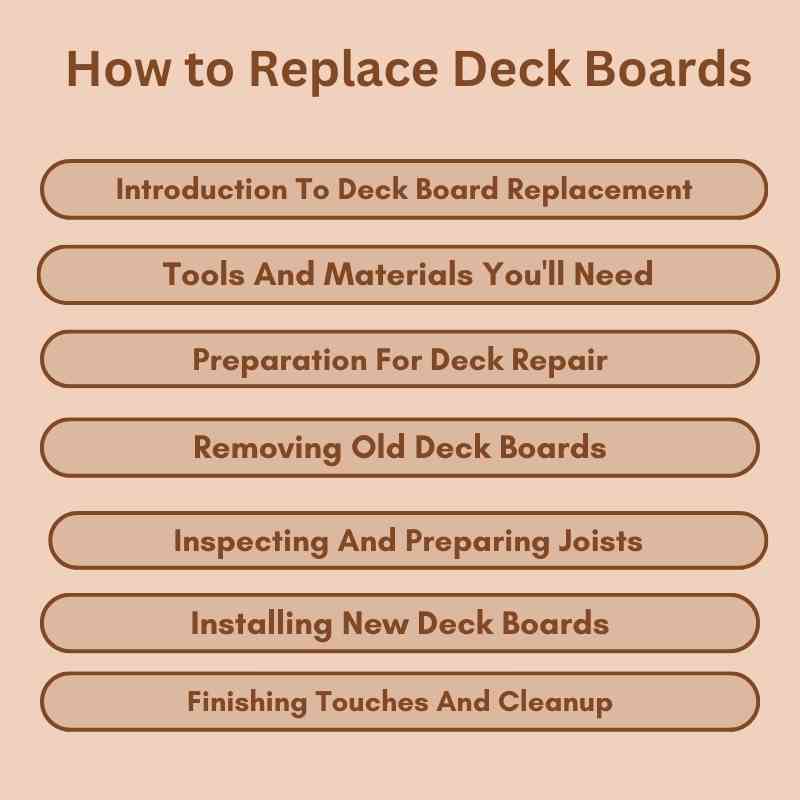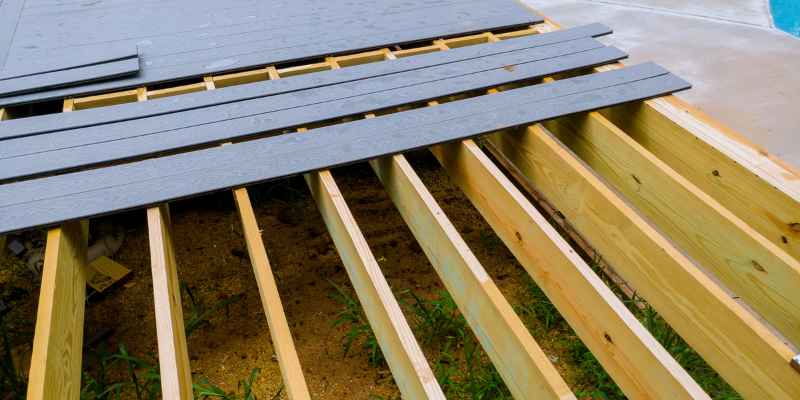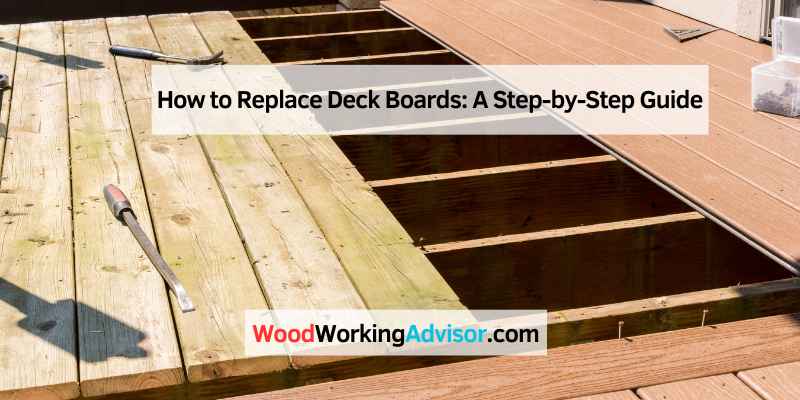To replace deck boards, start by removing the old boards using a circular saw and a pry bar. Then, measure and cut the new boards to fit, and secure them to the joists using screws or nails.
It’s important to inspect the joists for any damage and make any necessary repairs before installing the new boards. Additionally, ensure that the new boards are properly aligned and spaced to maintain the structural integrity of the deck. Replacing deck boards is a straightforward process that can rejuvenate the look and functionality of your deck.
Whether you’re dealing with rotting or worn-out boards, replacing them can extend the lifespan of your deck and enhance its overall appeal. In this guide, we’ll explore the step-by-step process of replacing deck boards and provide helpful tips for a successful replacement project.
Introduction To Deck Board Replacement
Replacing deck boards is a crucial aspect of deck maintenance to ensure the safety and longevity of your outdoor space. Over time, deck boards can become worn, warped, or rotted due to exposure to the elements, which can compromise the structural integrity of the deck. In this guide, we will explore the process of replacing deck boards, including why it’s necessary, how to assess your deck’s condition, and the steps involved in the replacement process.
Why Replace Deck Boards?
Deck boards are subjected to constant exposure to sunlight, moisture, and foot traffic, leading to wear and deterioration over time. It’s essential to replace deck boards to maintain a safe and functional deck. Rotted or damaged boards can pose safety hazards and detract from the aesthetic appeal of the deck. By replacing deteriorating boards, you can prevent further damage and prolong the lifespan of your deck.
Assessing Your Deck’s Condition
Prior to replacing deck boards, it’s crucial to assess the overall condition of your deck. Check for signs of rot, warping, or decay in the existing boards, as well as the integrity of the underlying joists and support structure. Assessing the deck’s condition will help determine the extent of the replacement needed and ensure that the underlying structure is sound before installing new boards.

Tools And Materials You’ll Need
To replace deck boards, you’ll need essential tools like a circular saw, pry bar, and safety gear. Ensure to mark, cut, and install new boards carefully for a sturdy deck. Remember to inspect joists and use proper techniques to remove old boards efficiently.
If you’ve noticed that your deck boards are looking worn or showing signs of rot, it’s time to replace them. This is a project that you can do yourself with the right tools and materials. Here’s what you’ll need:
List Of Essential Tools
| Tools | Materials |
| Circular saw | New deck boards |
| Screwdriver | Wood hardener/filler/epoxy |
| Hammer | Deck screws |
| Nail puller | Joist tape |
| Pry bar/crowbar | Paint or stain |
| Measuring tape |
Choosing Replacement Boards
When selecting new deck boards, it’s important to choose boards that match the size and thickness of your current boards. This will ensure that they fit properly and are flush with the surrounding boards. Make sure to also select boards that are free from knots, cracks, and other defects.
It’s also a good idea to choose boards that are pressure-treated or have been treated with a water-resistant sealer to help prevent future rot and decay.
With the right tools and materials, replacing deck boards can be a straightforward DIY project that will give your deck a fresh look and help extend its lifespan.
Preparation For Deck Repair
To replace deck boards, start by inspecting the old boards for any rot or damage. Use a circular saw to cut lines into the planks and then remove them with a pry bar. Measure and cut the new boards to size, making sure to square them properly before securing them to the joists.
Before you start replacing deck boards, it’s important to properly prepare your work area and consider safety precautions. This will ensure a smooth and efficient process, minimizing any potential risks. In this section, we will discuss two crucial aspects of deck repair preparation: clearing the work area and safety considerations.
Clearing The Work Area
To begin, it’s essential to clear the work area to create a safe and organized space for the deck repair. Follow these steps:
- Remove any furniture, planters, or other items from the deck.
- Sweep the deck to remove any debris, leaves, or dirt that may have accumulated.
- If there are any nails or screws sticking out from the old deck boards, use a hammer or pry bar to remove them.
- Ensure that the area around the deck is clear as well, to prevent any accidents or obstruction during the repair process.
Safety Considerations
When it comes to deck repair, safety should always be a top priority. Take the following safety precautions before starting the repair:
- Wear appropriate protective gear, such as safety goggles, gloves, and sturdy footwear.
- Make sure you have a stable ladder or scaffolding if you need to access higher areas of the deck.
- Check the stability of the existing deck structure and make any necessary repairs or reinforcements before replacing the boards.
- Use caution when handling tools, such as saws or nail pullers, and follow the manufacturer’s instructions for safe usage.
- If you’re unsure about any aspect of the repair process, it’s advisable to consult a professional to ensure the job is done safely and correctly.
By taking the time to properly prepare your work area and adhere to safety considerations, you’ll create a solid foundation for a successful deck repair. These initial steps will help make the process smoother, ensuring that the replacement of deck boards is done effectively and without any unnecessary risks.
Removing Old Deck Boards
When it comes to replacing deck boards, the first step is to remove the old ones. This process can be straightforward if you follow the right techniques. In this section, we will discuss cutting and lifting techniques, as well as how to handle stubborn boards.
Cutting And Lifting Techniques
To begin the removal process, you will need a few tools and materials. Gather a circular saw, pry bar or crowbar, and safety equipment such as gloves and goggles.
Here are the steps to cut and lift the old deck boards:
- Start by marking the boards you plan to remove. This will help you stay organized and ensure you don’t accidentally remove the wrong ones.
- Using a circular saw, cut lines into the planks along the marked areas. Adjust the saw depth to avoid damaging the joists beneath.
- Once the lines are cut, you can begin lifting the planks. Utilize a pry bar or crowbar to gently lift and pry up the planks from their position.
- Work methodically, removing one plank at a time. This will help maintain the structural integrity of the deck and make the process more manageable.
- Inspect the joists as you remove the old boards. Look for any signs of damage or rot that may require additional repairs or replacements.
Handling Stubborn Boards
Sometimes, you may encounter stubborn boards that are difficult to remove. Here are some tips to handle them:
- If a board is stuck, try tapping it gently with a hammer to loosen it from its position.
- Apply a lubricant such as WD-40 to the edges of the board to help reduce friction and make it easier to lift.
- Use a reciprocating saw with a metal-cutting blade to carefully cut through any nails or screws holding the board in place.
- If all else fails, you may need to use a sawzall or similar tool to completely cut through the stubborn board.
By following these cutting and lifting techniques, as well as handling stubborn boards effectively, you will be well on your way to successfully removing old deck boards. Once the old boards are removed, you can proceed with installing the new ones to give your deck a fresh and updated look.
Inspecting And Preparing Joists
Inspecting and preparing joists is an essential step when replacing deck boards. By carefully examining the condition of the joists and ensuring they are structurally sound, you can ensure a successful and long-lasting deck board replacement.
Identifying Joist Damage
Before replacing deck boards, it’s crucial to inspect the joists for any damage. Start by checking for rot, cracks, or splitting on the joists. Use a screwdriver to probe the wood gently and see if it’s soft or spongy. If it is, that’s a sign of rot. Also, look out for any rusted or corroded joist hangers, as they can weaken the structure of the deck.
Joist Repair And Treatment
If you find any damage to the joists, it’s essential to repair and treat them before replacing the deck boards. For minor damage, you can use a wood hardener or filler to strengthen the area. For more severe damage, you may need to replace the affected section of the joist entirely. Additionally, treating the joists with a water-repellent solution can help prevent future damage.
When preparing the joists for the new deck boards, ensure that they are level and securely attached to the ledger board. You can use shims to level any uneven joists. Also, check that the joist spacing is correct for the new deck boards. The spacing should match the manufacturer’s recommendations for the specific type of board you’re using.
By inspecting and preparing the joists, you can ensure the structural integrity of your deck. Remember to take your time and make any necessary repairs before installing the new deck boards.
Installing New Deck Boards
Learn how to replace deck boards with these easy steps. Start by marking the boards, then use a nail puller to remove the old ones. Inspect the joists and cut the new boards to size before installing them. Finally, cover any exposed nails and square the boards for a professional finish.
Measuring And Cutting Boards
Begin by measuring the length needed for the new deck boards. Use a tape measure to ensure accuracy.
Mark the cutting lines on the boards with a pencil. Double-check measurements before cutting.
Cut the boards to the correct size using a saw. Wear safety goggles during this step.
Securing Boards To Joists
Place the board onto the joists, ensuring it is positioned correctly.
Use screws or nails to secure the board to the joists. Pre-drill holes to prevent splitting.
Check for alignment and adjust as needed before fastening the board in place.
Finishing Touches And Cleanup
To complete the replacement of deck boards, don’t forget about the finishing touches and cleanup. Make sure to cover any exposed nails, inspect the joists, and square the new boards before making the final cut. By following these steps, you can ensure your deck looks great and is safe to use.
Sanding And Sealing
After replacing the deck boards, sanding them smooth is crucial for a polished finish. Sealing the boards will protect them from the elements and extend their lifespan.
Disposing Of Old Materials
Properly disposing of the old materials is essential for a clean workspace. Recycle where possible and dispose of the rest responsibly.
Finishing Touches and Cleanup
Once the new deck boards are in place, it’s time for the finishing touches. Sanding and sealing the boards will enhance their appearance and durability. Properly disposing of the old materials is important for a clean workspace. Recycle where possible and dispose of the rest responsibly.

Maintenance And Prevention Tips
Learn how to replace deck boards with these simple maintenance and prevention tips. Identify the type of wood and use a circular saw to cut and remove the old boards carefully. Install the new boards, ensuring they are properly aligned and secured to keep your deck looking fresh and sturdy.
Regular Deck Inspections
Inspect your deck regularly for signs of wear and damage.
Look for rot, cracks, or loose boards that may need replacement.
Preventative Measures For Longevity
- Apply a protective sealant to prevent moisture damage.
- Keep your deck clean from debris and leaves to avoid decay.
- Regularly sweep and clean to prevent mold and mildew growth.
Frequently Asked Questions
Can I Just Replace The Boards On My Deck?
Yes, you can replace the boards on your deck by cutting out the old ones and adding new ones. If the look bothers you, consider replacing the whole deck. Otherwise, it’s a simple process, but you may want to hire a professional for assistance.
Where Do I Start When Replacing Deck Boards?
To start replacing deck boards, follow these steps:
1. Mark the damaged boards for removal.
2. Use a circular saw to cut lines into the planks.
3. Pry up the planks one at a time using a pry bar or crowbar.
4. Remove any remaining nails or screws from the joists.
5. Install new boards, making sure they are flush with the joists.
6. Secure the new boards with nails or screws.
7. Repeat the process for all damaged boards. Remember, if you’re unsure or uncomfortable with the process, it’s best to hire a professional.
How To Remove Old Deck Boards?
To remove old deck boards, use a circular saw to cut plank lines, then pry up the planks with a pry bar. Work methodically, removing one plank at a time. Be careful not to damage the joists. This process allows for easy replacement with new, sturdy boards.
How To Fix Rotted Deck Boards?
To fix rotted deck boards, follow these steps:
1. Gather tools and materials.
2. Apply wood hardener, filler, or epoxy to strengthen minor damage.
3. Use a circular saw to cut and a pry bar to lift the planks.
4.Replace with sturdy new boards.
Conclusion
Replacing deck boards is a relatively simple process that can improve the overall appearance and functionality of your deck. By following the steps outlined in this blog post, you can easily remove old, damaged boards and install new ones. However, if you are not confident in your DIY skills, it may be worth hiring a professional to ensure the job is done correctly.
Remember to assess the condition of your deck and consider replacing the entire deck if necessary.

